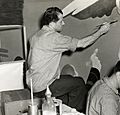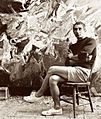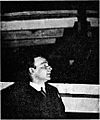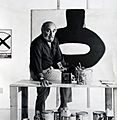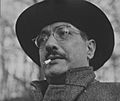9th Street Art Exhibition facts for kids
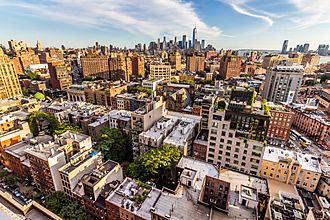
"Greenwich Village" by Felix Stahlberg, 2017.
|
|
| Date | Monday, May 21, 1951 to Sunday, June 10, 1951 |
|---|---|
| Duration | 20 days |
| Venue | 60 East 9th Street, New York, New York 10003 |
| Location | Greenwich Village, Manhattan, New York City, United States |
| Also known as | "Ninth Street Show" and "9th Street Show" |
| Type | Abstract Expressionism |
| Theme | Group Show |
| Organized by | Leo Castelli, curator and financial backer. Franz Kline, promotional designer. Aaron Siskind, event photographer. |
| Participants | Key figures in abstract expressionism, America's first internationally influential art movement. |
The 9th Street Art Exhibition of Paintings and Sculpture was an important art show held in New York City in 1951. It's also known as the Ninth Street Show. This exhibition was special because artists themselves organized it. It was the first big public showing for a new American art style called Abstract Expressionism. This style became the first American art movement to be famous around the world.
Before this, Paris was the main place for new art. But after World War II, New York City became a new center for exciting art. Artists like Willem de Kooning and Jackson Pollock became very well-known. The Ninth Street Show helped these artists, and about 75 others, become famous. Many of these artists were not well-known before the show. They included Helen Frankenthaler, Joan Mitchell, Grace Hartigan, and Lee Krasner. The art world at the time often ignored new, experimental art.
This show was meant to help artists make a name for themselves, and it worked! Even though nothing was sold, the artists got a lot of attention. Their art style, called the New York School, was later seen as a truly American art movement. It felt like a big step into a new and exciting art world.
How the Exhibition Was Organized
The Club: A Meeting Place for Artists
In the late 1940s and early 1950s, many painters and sculptors had art studios in lower Manhattan. They were known as the Downtown Group. Many of them had worked on government art projects before. Some had also served in World War II.
In 1949, some of these artists, led by Philip Pavia, formed a group called "The Club." They met regularly to talk about art. During these discussions, they came up with the idea for the 9th Street Art Exhibition. They wanted it to be a way to show their work to the world.
The Artists Who Showed Their Work
Many artists wanted to be part of the show. Each artist could only show one piece of art. At first, some wondered if including women artists would make the show seem less serious. But in the end, the jury picked eleven women and sixty-one men. These artists represented the new art scene in downtown New York. They lived in cheap industrial lofts and were very dedicated to abstract art. In total, 74 artists showed their work.
Examples of Art from the Show
(These are examples of work by artists who were in the show.)
-
Willem de Kooning. Litho #2 (Waves #2), 1960.
-
Lee Krasner. Untitled Mural Study, 1940.
-
Aaron Siskin. Cover for Big Table magazine, 1959.
Artists by Name
(This list comes from the original poster for the show.)
- L. Alcopley (1910–1992)
- Rene Robert Bouche (1906–1963)
- Theodore Brenson (1893–1959)
- James Brooks (1906–1992)
- Peter Busa (1914–1985)
- Giorgio Cavallon (1904–1989)
- Nicolas Carone (1917–2010)
- Elaine de Kooning (1918–1989)
- Willem de Kooning (1904–1997)
- Robert De Niro, Sr. (1922–1993)
- Enrico Donati (1909–2008)
- Friedel Dzubas (1915–1994)
- Jimmy Ernst (1920–1984)
- Herbert Ferber (1906–1991)
- John Ferren (1905–1970)
- Perle Fine (1908–1988)
- Helen Frankenthaler (1928–2011)
- Michael Goldberg (Stuart) (1924–2007)
- Robert Goodnough (1917–2010)
- Clement Greenberg (1909–1998)
- Peter Grippe (1912–2002)
- Philip Guston (1913–1980)
- Grace Hartigan (George) (1922–2008)
- Hans Hofmann (1880–1966)
- Harry Jackson (1924–2011)
- Hugh Kappel (1910–1982)
- Earl Kerkam (1891–1965)
- Franz Kline (1910–1962)
- Gitou Knoop (1909–1985)
- Albert Kotin (1907–1980)
- Lee Krasner (1908–1984)
- Alfred Leslie (1927–)
- Richard Lippold (1915–2002)
- Seymour Lipton (1903–1986)
- Conrad Marca-Relli (1913–2000)
- Boris Margo (1902–1995)
- George McNeil (1908–1995)
- Joan Mitchell (1925–1992)
- Robert Motherwell (1915–1991)
- Costantino Nivola (1911–1988)
- Jackson Pollock (1912–1956)
- Fairfield Porter (1907–1975)
- Richard Pousette-Dart (1916–1992)
- Melville Price (1920–1970)
- Ad Reinhardt (1913–1967)
- Milton Resnick (1917–2004)
- Robert Richenburg (1917–2006)
- Robert Rauschenberg (1925–2008)
- James Rosati (1912–1988)
- Anne Ryan (1889–1954)
- Joop Sanders (1921–)
- Louis Schanker (1903–1981)
- Day Schnabel (1905–1991)
- Sonia Sekula (1918–1963)
- Aaron Siskind (1903-1991)
- David Smith (1906–1965)
- Theodoros Stamos (1922–1997)
- Joe Stefanelli (1921–)
- John Stephan (1906–1994)
- Jean Steubing (1929–)
- Yvonne Thomas (1913-2009)
- Bradley Walker Tomlin (1899–1953)
- Jack Tworkov (1900–1982)
- Esteban Vicente (1903–2001)
Photos of Artists
(These are photos of some artists who were in the show.)
-
Painter Philip Guston in 1940.
-
Painter Conrad Marca-Relli in 1982.
-
Graphic artist Robert Rauschenberg in 1968.
-
Painter Mark Rothko in the 1940s.
Who Paid for and Organized the Show?
The building for the exhibition was old and needed repairs. The rent for the entire show was only $70. But many of the artists were very poor. Leo Castelli, who later became a famous art dealer, paid for the rent and most other costs. This was his first time organizing an art show. He also helped hang all the artwork. Artists chose him because they thought he would be fair.
Artist Franz Kline designed the posters and other materials for the show. This poster gave the show its official name. Photographer Aaron Siskind took pictures of the exhibition. After the show, artists were happy. Not only did art dealers and museum people come, but they also felt like they had created a strong art community.
The Show's Lasting Impact
How It Changed American Art
The Ninth Street Show helped define and promote Abstract Expressionism. Art critics wrote about it, which helped the movement grow. For example, critic Harold Rosenberg wrote an essay in 1952. He described artists like Willem de Kooning as heroes expressing themselves through art.
Important critics like Clement Greenberg, and collectors like Peggy Guggenheim, also supported the movement. Even museum curators like MoMA's Alfred H. Barr Jr. helped. Abstract Expressionism became popular among the art world's elite in New York.
Greenberg even said that for the first time, the most advanced art was coming from New York, not Europe. He believed artists like Pollock and De Kooning were carrying on the work of European modern artists.
However, the general public wasn't as excited about this new art. So, few local galleries showed these artists' works. One exception was The Stable Gallery. It was a converted horse stable that hosted annual art shows. It showed works by some of the "Ninth Street Show" artists from 1953 to 1957.
Clement Greenberg wrote an introduction for the poster of the second annual show at The Stable Gallery in 1953. He praised the Ninth Street Show. He said it set an example for showing bold new art because artists themselves organized it. He wrote that the show's impact was still felt years later.
The Role of Women Artists
Sixty-one men and eleven women showed their art in the Ninth Street Exhibition. Five of these women became internationally famous artists. Their work is now in major museums. These artists were Grace Hartigan, Helen Frankenthaler, Joan Mitchell, Elaine de Kooning, and Lee Krasner. Lee Krasner was the oldest, but her career truly took off after Jackson Pollock's death in 1956. She had 28 very productive years after that.
In 2018, author Mary Gabriel wrote a book about these five women. It's called Ninth Street Women. The book highlights their important contributions to American art. It made people more interested in the often-overlooked women of Abstract Expressionism.
Because of the book's success, Amazon Studios decided to make it into a TV series. Also, the University of California, Los Angeles (UCLA) created an art history class about these women. They used Gabriel's book as a textbook.
Other Exhibitions Like It
- In 2006, the Findlay Fine Art Gallery in New York City had a show. It honored the lesser-known artists from the 9th Street Art Exhibition.
- In 2016, the Denver Art Museum opened "Women of Abstract Expressionism." It featured over 50 major paintings by women artists from the 1940s and 1950s.
- Also in 2016, a gallery in Los Angeles called Hauser Wirth & Schimmel opened with a show. It was called “Revolution in the Making: Abstract Sculpture by Women, 1947–2016.”
Images for kids







